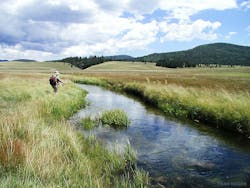Groundwater Use in Little Rock Creek, Minn. Impacting Trout Habitat & More
Groundwater use around Little Rock Creek, Minn. is up, and that could have effects on trout habitat and other parts of the watershed.
According to Saint Cloud Times, the Minnesota Department of Natural Resources (DNR) released a five-year plan for sustainable groundwater use in the Little Rock Creek area. Depending on the results of the study, the state may consider limits on groundwater withdrawals in coming years.
According to Little Rock Creek area planning project manager Mark Hauck, use of groundwater around Little Rock Creek increased over decades, more than in other parts of Minnesota.
“Water use is high compared to the flow of water into and through the LIttle Rock Creek watershed,” Hauck said. “Minnesotans want groundwater to support economic development, but they want it to be sustainable.”
More than 5,500 people live in the Little Rock Creek area, this includes the cities of Royalton, Buckman, and Rice.
According to Hauck, groundwater feeds Little Rock Creek by seeping through its banks. The state has it stocked with trout, and the trout reproduce on their own.
“It’s a unique resource,” Hauck said. “It’s a unique regional resource by recreation and wildlife habitat.”
The DNR manages the sustainability of the state’s surface and groundwater.
According to the DNR’s action plan, one of its objectives is “high volume use of groundwater must not harm ecosystems, aquifers or creative negative impacts to surface waters.”
About 96% of the area groundwater use from 2008 to 2017 went to agricultural crop irrigation. Private well use made up about 1% and municipal water us made up to 2.5%.
“Minnesota Pollution Control Agency identified groundwater use as a contributing factor to water quality problems in Little Rock Creek,” according to the DNR’s plan.
The DNR has a five-year plan that involves continuous public communication, monitoring stream flow and temperature as well as groundwater levels. Officials will collect data on fish habitats and analyze groundwater flows.
The DNR will study the the feasibility of different interventions, including pumping water into the creek during low-flow times, adjusting water appropriations or changing water level management in the Sartell Wildlife Management Area.
